Snake Bites on Dogs: What to Do if Your Dog Gets Bit
Posted: 05/23/2023 | BY: Erin Cain | Categories: Dog , Health problems , Pet care , Top Tips
Summertime means snake sightings and, unfortunately, snake bites on domestic dogs. Veterinarians see an uptick in snake bite cases between April and October every year. If you are a pup parent, it’s essential to know what to do if your dog gets bitten by a snake. This article will discuss snake bites on dogs, treating snakebites, and what pet owners can do if a venomous snake bites their dog.

Why do snakes bite?
When a snake bites another animal, it will only do so in self-defense. Snakes lack limbs and claws, making them ill-suited for attack situations with other animals. All they have to defend themselves is their teeth. A domestic dog typically won’t experience snakebites unless he is too curious, too stubborn, or simply sticks his nose in the wrong place at the wrong time.
How severe is a snake bite? It depends on a variety of factors, starting with what type of snake your dog was bit by and whether it is a venomous snake or not.
Type of snake
Some snakes are poisonous, and others aren’t. However, some non-poisonous species can still generate a bite which may lead to an infection in your dog and, with that bite, severe pain. As for venomous snake bites, the risk of venomous bites being fatal is genuine and must be treated promptly by an experienced veterinarian or doctor.
The type of snake that bit your pet can significantly impact how sick it gets. Some species are more venomous than others. The snake’s toxic venoms mean the bite’s effects could come later rather than immediately after being bitten.
The location of the bite
The most common places for dogs to get bitten by snakes are their face, neck, or legs. However, dogs can be attacked by snakes anywhere on their body. It’s critically important to know that the closer a bite is to the heart, the faster it spreads through a dog’s body. Do not hesitate to get your dog to a veterinarian or emergency clinic as soon as possible if you suspect a snake has injured him.
Amount of venom
Snake bites on dogs happen more frequently during the warmer months because the snakes’ venom glands are fuller. However, the amount of venom in a poisonous snake can vary depending on the maturity and size of the snake.
The dog is the most common snake-bitten domestic animal, but up to 80% of dogs will survive with quick treatment.
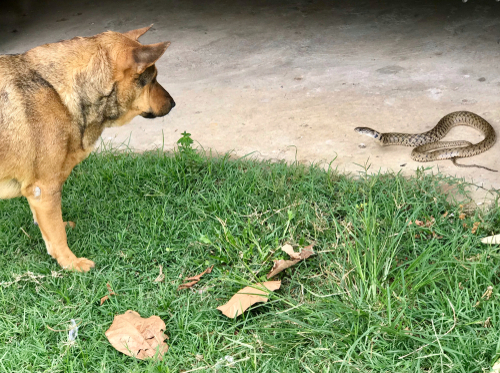
How do you know a snake has bitten your dog?
When a snake bites your dog, it’s essential to know the types of symptoms and their severity. The symptoms of the bite depend on a variety of factors:
- whether or not the snake injected your dog with venom
- how many bites on the dog
- where the snake bit the dog.
Symptoms of snake bites on dogs
Non-venomous snake bites on dogs are usually not harmful, but they can cause swelling and bruising at the contact site, and they are quite painful. The bruise will spread quickly around wound created by a snake’s fangs, although this injury can be challenging to spot on dogs with thick, long fur. The type and size of the snake will determine whether or not you can see any puncture wounds on your dog’s skin.
The symptoms of venomous snake bites on dogs are likely to be more severe than those from other types of snakes. Signs your dog might display after being bitten include:
- trembling, twitching, or shaking
- bruising and skin discoloration
- vomiting
- diarrhea
- shallow breathing
- bleeding from the wound, mouth, or nose
- incontinence
- excessive panting
- lethargy
- bloody urine
- weakness and sudden collapse, followed by the dog getting up normally
- drooling, frothing, or excessive salivation
- dilated pupils
- weakness in the hind legs
- paralysis
- shock
- low blood pressure
- aggression due to extreme pain
If a venomous snake bites your dog, you may notice dramatic symptoms starting within moments of the bite occurring. Your dog may begin to tremble or twitch, particularly in the back legs, and his eyes will start dilating. Your dog’s legs will weaken, causing him to collapse. He will most likely feel nervous, anxious, and frustrated if this happens. At this point, the dog will also pant heavily and begin to drool or froth at the mouth. Some dogs will experience diarrhea, while others will vomit.
If your dog exhibits these signs after encountering a venomous snake, you must take him straight to the veterinarian. Up to 30% of dogs bitten by a poisonous snake die; thus, immediate diagnosis and treatment by a veterinarian are necessary to give your dog a chance to live.

What are the most common poisonous snakes?
The risk of a bite from any given snake is low, but if your dog comes across one with venomous fangs, then things can get very serious, fast. These are the most common venomous snakes in the United States:
Rattlesnakes
The rattlesnake is a venomous snake that can be found all over North America and can reach six feet in length. They usually have reddish or brown bodies with darker diamond-shaped patterns on their backs. Of course, they have rattles on the end of their tails (hence their name) which they shake to make an unmistakable warning sound.
The rattlesnake has all the features that make up an intimidating creature. Rough scales cover its body, with a pair of fangs in its upper jaw, pits beneath its slit-eyed pupils, and a large arrow-shaped head.
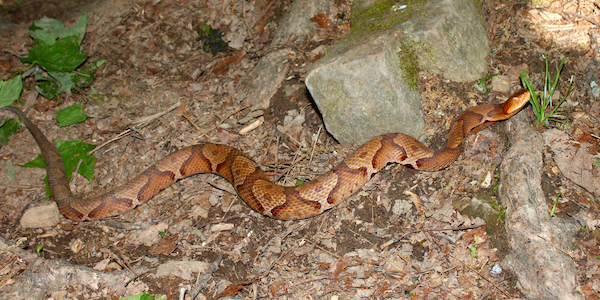
Copperheads
Copperheads are usually brown, but they can be reddish to golden tan in color. They often have darker hourglass bands along their body and reach up to three feet in length. These snakes live near wood piles or leaf litter, where they can easily blend into the surrounding environment.
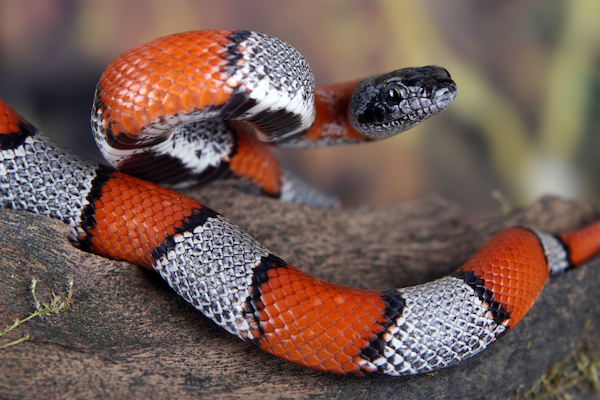
Coral snakes
The coral snake is a small, slender, black-nosed reptile with vivid stripes of red and yellow that are always next to each other. This snake grows between 18 and 20 inches long, although some coral snakes may grow up to three feet long. The coral snake can be found in various regions of North America and has the second-strongest venom of any snake after the black mamba. However, the coral snake is considered less dangerous than a rattlesnake due to its small size and less effective poison delivery system.
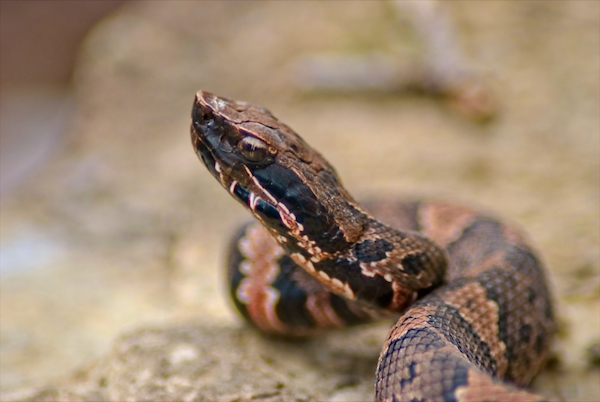
Water moccasins (cottonmouth or pit vipers)
Water moccasins are typically found near streams or in swamps. They can grow up to six feet long and have dark brown skin with faint bands often tricky for the casual observer to distinguish. The water moccasin, also called the cottonmouth, has a white interior mouth. This trait gives it its nickname and is its main identifying feature.
The sooner the vet knows about a possible bite, the more options are available for treatment. If you spot the offending snake and can provide some information about what kind of snake it was or how big it was, these details will help dictate the vet’s course of action. If you have your phone and are a safe distance from the reptile, snap a picture of the snake to show the vet.
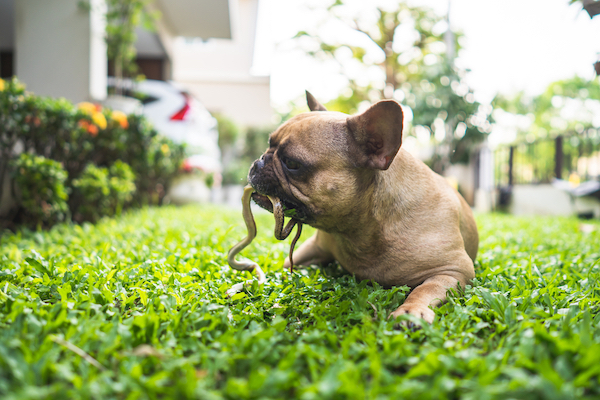
Don’t treat snake bites on dogs at home!
Should your pup be bitten by a snake, whether venomous or not, immediately take him to the veterinarian or emergency animal clinic.
Your veterinarian can treat snakebites quickly if they are not severe or venomous. The vet will thoroughly flush and clean the area around the bite and provide antibiotic and anti-inflammatory medications to ease your dog’s pain.
There are steps you should take between recognizing that your dog has been bitten and getting him to an emergency animal clinic:
- Stay calm, and soothe your dog. Dogs can sense their owners’ panic, which can cause stress levels in the body to increase. The snake venom circulated in the blood will move more rapidly than usual. Do not, under any circumstances, try to suck the poison out of your dog’s wound!
- If your dog is poisoned, the venom could cause him to experience shock or paralysis. Swelling may occur, causing the throat or nostrils to close. Remove your pup’s harness and collar to keep the airways from becoming obstructed. Be prepared to give your dog CPR techniques if necessary.
- Keep your dog as still and quiet as possible on the way to the veterinary clinic. Movement can cause the poison to circulate faster through the bloodstream. Do everything you can to keep the bitten area below your dog’s heart level to slow down the spread of the venom.
- To help slow down your pup’s circulation, turn up the air conditioning in your car, and apply ice or an ice pack directly to any wounds. The ice pack should remain on the bitten area until you arrive at the veterinary clinic.
- If you see any bite marks on your dog, rinse them off with water or use a baby wipe to remove the venom from the skin.
When you arrive at the vet’s office, the vet will examine your dog and treat him with antivenin. As a commercially-made serum, antivenin is sometimes explicitly designed for the type of snake venom. That’s why it’s important to share any information with the vet about what kind of snake bit your dog so he is treated with appropriate antivenom.
Your dog may have a bite from a non-venomous snake, but you should still visit the vet to make sure the wound is not infected so your pup can receive antibiotic treatment.
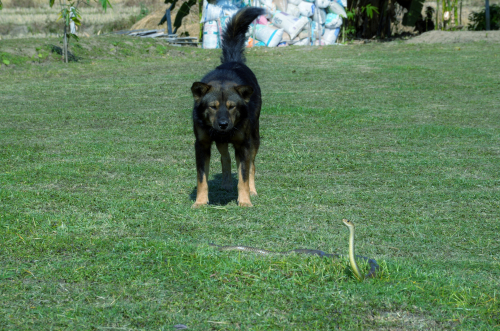
The prognosis for dogs with snakebites
A dog may not be able to survive a venomous snake bite if treatment isn’t given quickly enough. A two-hour window after the snake bite is critical to a canine’s life and qualifies as a medical emergency. If your dog does not receive veterinary treatment by this point, he may die from the poison.
However, with prompt care and medical attention, your four-legged friend has an excellent chance of recovery. Most dogs show signs of recovery within 24 hours of receiving treatment. If not, the dog’s prognosis is poor. Snake bites to the chest or abdomen are most likely to be fatal.
Even if a dog survives a venomous snake bite, he may suffer long-term, secondary medical complications, and health conditions from the encounter. Issues such as neurotoxicity, cardiovascular toxicity, tissue damage, and blood clotting problems are some of the known side effects of a venomous snake bite in dogs.
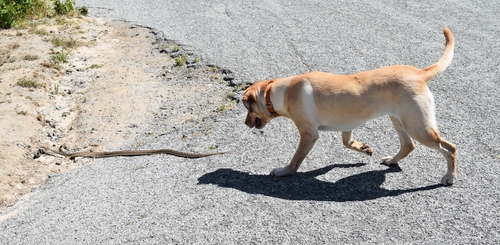
How can you prevent snake bites on dogs?
Most dogs bitten by snakes are in the wrong place at the wrong time. However, there are steps you can take to limit the potential contact between your pup and snakes:
- Keep your yard clean of debris and tall grass, and don’t overwater your lawn. Avoid creating wood piles and leaf piles, and prevent rodents and other small animals that are often food for snakes from inhabiting your property. Long grass is a great hiding place for snakes, so make sure to cut your lawn frequently. Additionally, when too much water pools on the lawn or in a yard, it can attract prey species such as worms and slugs, which may make perfect meals for snakes to eat.
- Avoid leaving food outside whenever possible. If you can, avoid feeding your pets outdoors. If you must, store pet foods in metal cans with tight-fitting lids for protection against rodents that will attract snakes to your yard. Also, if you have a bird feeder, either consider not feeding them or place the feeder away from your home. Birds spill seeds on the ground, attracting mice and rats, and bringing snakes to the territory.
- Keep your dog on a leash when walking and hiking. This step is critical if you live in a wooded, grassy area or in a place where snakes are known to be; location is everything. Keeping a close eye on your dog will help you avoid any unfortunate snake encounters. Stay on main paths or sidewalks and away from tall grasses, rocks, or holes where snakes may be hiding. Watch the ground and prevent your pup from sticking his nose into grasses, leafy piles, and near locations with fallen trees or wood.
- Enroll your dog in snake aversion training. Yes, some classes can train your dog to learn the smell, sight, and sound of a snake and avoid it. Some of these classes use shock collars for training; however, shocking a dog can have significant negative consequences. Instead, look for a training facility that uses positive training methods only. Your dog can learn to steer clear of snakes, even when you’re not by his side, and in a positive environment.
Keep your pup safe with pet insurance.
Accidents happen to our dogs, and snake bites on dogs can be one of those unexpected events that quickly turn into a medical emergency. Your dog depends on you for medical help, so don’t get caught off guard when the unexpected occurs. Let Pet Insurance Review find the best insurance policy for your dog’s needs. A pet insurance plan for your dog gives him top medical care and reimburses you a percentage of the vet costs. Get a free pet insurance quote for your pup today!
References:
- Center for Disease Control. (2021). Venomous Snake Bites: Symptoms & First Aid. Retrieved from https://www.cdc.gov/niosh/topics/snakes/symptoms.html
- Gwaltney-Brant, S. (2020). Snakebite. Retrieved from https://www.cdc.gov/niosh/topics/snakes/symptoms.html
- Morris Animal Foundation. (2022). Close Encounters of the Slithering Kind — Snake Bites in Companion Animals. Retrieved from https://www.morrisanimalfoundation.org/article/close-encounters-snake-bites-companion-animals
- Hunter, T., Ward, E. (2022). Snakebite Envenomization. Retrieved from https://vcahospitals.com/know-your-pet/snakebite-envenomization
- South Arizona Veterinary Specialty & Emergency Center. (n.d.). What To Do Immediately After Your Pet Is Bitten By a Rattlesnake. Retrieved from https://www.southernazvets.com/immediately-pet-bitten-rattlesnake/
- Cain, E. (2022). CPR for Dogs: A 5-Step Guide. Retrieved from https://www.petinsurancereview.com/blog/cpr-dogs-5-step-guide
- Lee, J. (2022). Update on antivenom treatment in animals. Retrieved from https://vetgirlontherun.com/veterinary-continuing-education-update-antivenom-treatments-animals-raegan-wells-vetgirl-blog/
- Gilliam, L. (2008). Just Another Snake Bite? Pathophysiology, Treatment, & Long Term Effects. Retrieved from https://www.vin.com/apputil/content/defaultadv1.aspx?pId=11262&catId=32567&id=3865509
The information contained on this blog is intended for informational and educational purposes only and should not be construed as medical advice. It is not a substitute for professional veterinary care. Always consult with your veterinarian before making any changes to your pet's health care or treatment plan.
The authors of this blog are not veterinarians and do not claim to be experts in pet health. The information provided here is based on our own experiences and research, as well as information from reputable sources. However, we cannot guarantee the accuracy or completeness of this information.
We encourage you to do your own research and consult with your veterinarian before making any decisions about your pet's health.
Previous post
Are Catios Safe for Cats?Compare top pet insurance providers & plans.
Enter your dog’s age in years and months to calculate their age equivalent to human years.
Calculate your dog’s ageEnter your cat’s age in years and months to calculate their age equivalent to human years.
Calculate your cat’s age